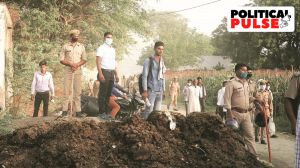- India
- International
Explained: A new Nipah outbreak in Kerala, and how lessons from Covid-19 might help in its containment
Nipah virus in Kerala: The global pandemic, which in India began in Kerala, and which continues to rage in the state even as cases in the rest of the country have largely tapered off, has imparted valuable lessons.
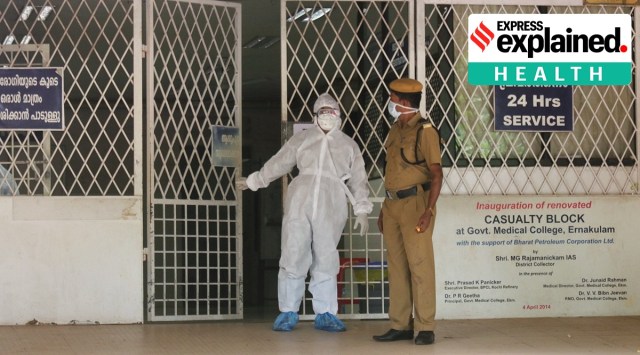 In this 2019 file photo, police stand guard outside the Nipah virus isolation ward at Govt medical College Ernakulam. (Express Photo: Nirmal Harindran, File)
In this 2019 file photo, police stand guard outside the Nipah virus isolation ward at Govt medical College Ernakulam. (Express Photo: Nirmal Harindran, File)A 12-year-old boy died in a private hospital in Kozhikode on Sunday (September 5), after being infected with the Nipah virus. The boy presented symptoms of encephalitis and myocarditis — inflammation of the brain and heart muscles respectively.
His samples, which were sent to the National Institute of Virology (NIV), Pune, have returned positive for Nipah. The central government said in a release that a team has been sent to Kerala to support the state in public health measures.
What is Nipah virus?
Nipah virus (NiV) is a ‘zoonotic’ virus, that is, it is transmitted to human beings from animals. The virus can also be transmitted through contaminated food, or directly between people.
The pathogen that causes NiV encephalitis is an RNA virus of the family Paramyxoviridae, genus Henipavirus, and which is closely related to the Hendra virus (HeV), which was isolated in Australia in 1994.
The animal host reservoir for both HeV and NiV is the fruit bat (genus Pteropus), which is commonly known as the ‘flying fox’. Infected fruit bats can spread the disease to other animals as well, such as pigs — and also dogs, cats, goats, horses and sheep.

Human beings can get infected if they come in close contact with the infected animal — bats or other animals such as pigs — or its body fluids such as saliva or urine. The initial jump of the virus from animal to human is known as a ‘spillover’ event in an outbreak.
Once the infection has moved to humans, person-to-person spread of NiV can occur.
How common are Nipah outbreaks?
The first outbreak was reported in Malaysia and Singapore in 1998-99. The name Nipah came from the name of the village in Malaysia, where the person in whom the virus was first isolated, died of the disease.
The virus appeared initially in domesticated pigs in this first outbreak. Nearly 300 humans were infected, and more than 100 died. A million pigs were culled to contain the spread of the infection.
While there have been no outbreaks in this region since then, India and Bangladesh have seen multiple outbreaks of NiV.
In Bangladesh, the virus appeared in 2001, 2003, 2004, 2005, 2007, 2008, 2010, and 2011. In India, the outbreaks have so far been limited to West Bengal and Kerala.
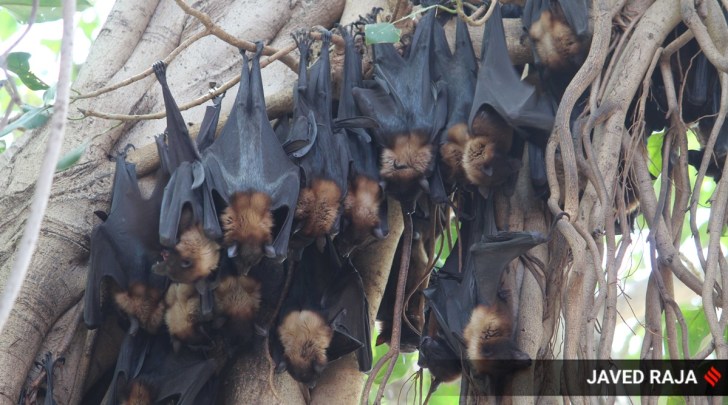 Human beings can get infected if they come in close contact with the infected animal — bats or other animals such as pigs — or its body fluids such as saliva or urine. (Express Photo: Javed Raja, File)
Human beings can get infected if they come in close contact with the infected animal — bats or other animals such as pigs — or its body fluids such as saliva or urine. (Express Photo: Javed Raja, File)
When has India seen NiV cases, and how bad have the outbreaks been?
The first outbreak in India hit Siliguri in West Bengal in January-February 2001. A total 66 cases were reported, with a high mortality rate of 3 out of every 4 infected persons.
In 2007, the virus returned to India, infecting around 50 people in the district of Nadia bordering Bangladesh. Around five people were reported to have died of the disease.
Nipah became widely known in India in May-June 2018, when 18 confirmed cases were reported in Kozhikode, of which 17 resulted in death, including the index case which could not be confirmed by laboratory tests.
Nipah virus: What are the symptoms, and how dangerous is it?
NiV infection can cause a mild to severe disease, which in the latter situation sees a major swelling in the brain (encephalitis), and can lead to death.
Symptoms of the infection can appear at any time from four days to two weeks after exposure to the virus. Patients usually report a fever and headache that can last from three days to a couple of weeks, accompanied by symptoms of respiratory illness such as cough, sore throat, and difficulty in breathing.
If the disease progresses to encephalitis, the patient may experience drowsiness, disorientation, and mental confusion, which can then progress very quickly to a coma within 1-2 days.
Between 40 per cent and 75 per cent of cases can lead to death, according to the World Health Organisation (WHO). However, the fatality rate in the 2018 outbreak in Kozhikode was well over 90 per cent.
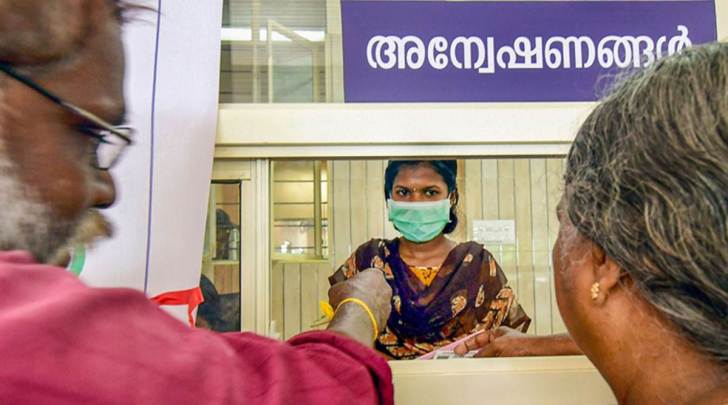 In this file image from 2019, hospital staff wear masks as a protective measure after reports of outbreak of Nipah virus, at Ernakulam Medical College in Kochi. (PTI Photo)
In this file image from 2019, hospital staff wear masks as a protective measure after reports of outbreak of Nipah virus, at Ernakulam Medical College in Kochi. (PTI Photo)
Those who have survived the disease have reported long-term side effects, among them persistent convulsions and, in some cases, changes in personality.
According to the United States Centres for Disease Control and Prevention (CDC) a few cases of ‘dormant’ or ‘latent’ infections, in which symptoms occur months or even years after exposure to the virus, have also been recorded.
How did Kerala handle the earlier Nipah virus outbreaks?
In 2018, the state health department had no past experience of handling a disease with such a high fatality rate. What the state then followed was the protocol for Ebola virus disease (EVD), which had been reported mainly in sub-Saharan Africa.
Accordingly, the state adopted the strategy of tracing the contacts of the infected persons, putting them under room isolation for 21 days. After tracing the contacts, their route maps were prepared to further identify the secondary contacts.
At one point in June 2018, around 3,000 people were under quarantine in Kozhikode and nearby Malappuram districts. Health Department employees visited the families of the deceased to identify the persons, including relatives who may have handled the bodies of those who died of Nipah.
All the persons who had direct or indirect contact with the suspected Nipah cases, were thus put under observation. A control room was opened at the district headquarters to coordinate the activities between various departments.
Those under isolation, many of them health workers, were given psychological support and counselling to help them tide over the mental trauma caused by the highly fatal outbreak.
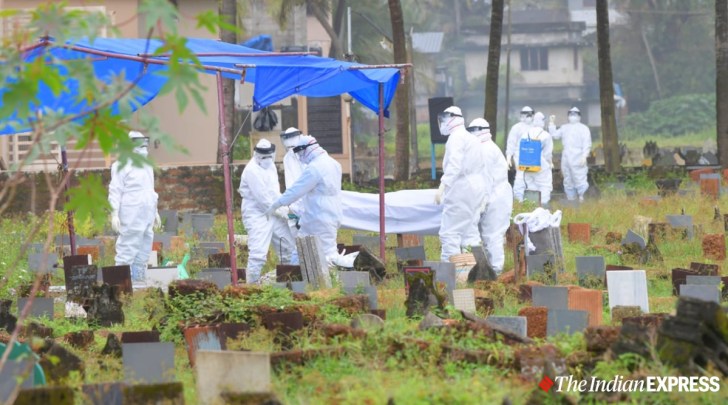 At the burial of the 12-year-old boy who died due to Nipah in Kerala (Express Photo)
At the burial of the 12-year-old boy who died due to Nipah in Kerala (Express Photo)
Twice in a day, the health department got in touch with those under isolation to get updates on their health status. Ambulances were deployed in the affected regions, mainly the eastern parts of Kozhikode district, to immediately pick up suspected patients from homes and to ferry them to a special isolation ward in the medical college.
The families of the persons under surveillance have since been given free ration kits containing 10 kg rice, 1 kg sugar, salt, green gram, toor dal, tea and spices.
When the state reported Nipah in 2019, for the second year in a row, the health department already had a protocol in place to handle the situation. In 2019, only one case was reported in Ernakulam district.
In 2020, the state did not report any Nipah case, but the protocol was updated and sent across the system.
Then Kerala Health Minister K K Shailaja earned international acclaim for helming the public health response to the virus threat.
Nipah virus: How is Kerala placed to handle the situation?
In 2018, the state health department was caught off-guard, and could diagnose the infection only after a few victims had died. The situation in 2021 is very different.
The ongoing battle against the Covid-19 pandemic, coupled with the lessons learned from the Nipah outbreak of 2018, is likely to make the task much easier at all levels for the government this time.
In 2018, the health department could diagnose the infection with the Nipah virus only after a few victims died. This time, it looks like there has been early detection of the infection, as the final confirmation came hours before the 12-year-old died.
What remains to be identified is how the boy got infected, and whether it is the index case in this outbreak.
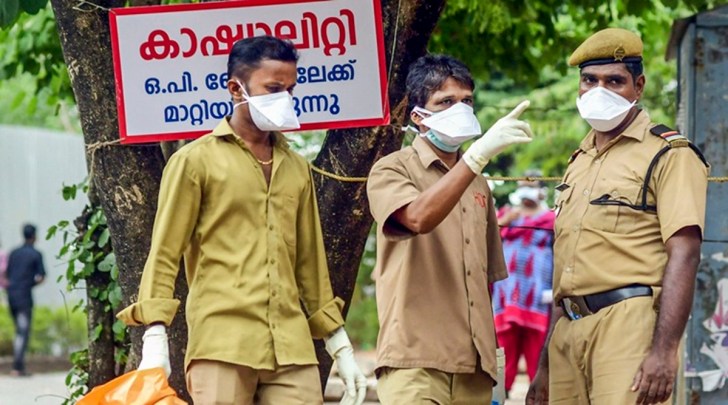 In this file 2019 image, security officials wear masks as a protective measure after reports of outbreak of Nipah virus, outside the Ernakulam Medical College in Kochi (PTI Photo)
In this file 2019 image, security officials wear masks as a protective measure after reports of outbreak of Nipah virus, outside the Ernakulam Medical College in Kochi (PTI Photo)
In 2018, the index case, a 27-year-old youth, reportedly got infected from fruit bats, which are common in his village, Changaroth, in Kozhikode. This time, the reported case hailed from the village of Chathamangalam, which is 50 km from Changaroth.
In 2018, the words ‘PPE kit’, ‘isolation’, ‘contact tracing’ and ‘quarantine’ were new to society at large. In hospitals, the infection control system was either not in place or was of a minimal level.
Now, with the prevalent Covid health protocol, health workers across the spectrum are generally wearing PPE kits, gloves, and masks, while attending to patients, especially those who have fever.
The global pandemic, which in India began in Kerala, and which continues to rage in the state even as cases in the rest of the country have largely tapered off, has imparted valuable lessons.
There is a higher degree of compliance among the public with regard to wearing masks. Nipah spreads among humans mainly through close contact with a person infected with NiV or their body fluids, including nasal or respiratory droplets, urine, or blood.
In 2018, most of those who caught the virus were infected at either the Perambra taluk hospital or the Kozhikode Medical College Hospital, where the first victim had been admitted.
 The police has cordoned off the area around the house of the Nipah virus victim in Kozhikode.
The police has cordoned off the area around the house of the Nipah virus victim in Kozhikode.
Many of the victims were then exposed to the droplets of the infected persons at hospitals. In fact, the health nurse Lini, who contracted the Nipah virus while taking care of the first index case at Perambra taluk hospital, did not have any PPE kit or a mask.
What containment strategies have been put into place now?
Three wards under Chathamangalam panchayat in Kozhikode, where the victim lived, were completely closed down on Sunday morning. Micro-level restrictions have gone into effect.
To and fro movement in these three wards have been completely banned. Police have put up barricades and checkpoints at all locations leading to the village of the victim.
Newsletter | Click to get the day’s best explainers in your inbox
More Explained
EXPRESS OPINION
Apr 27: Latest News
- 01
- 02
- 03
- 04
- 05






















